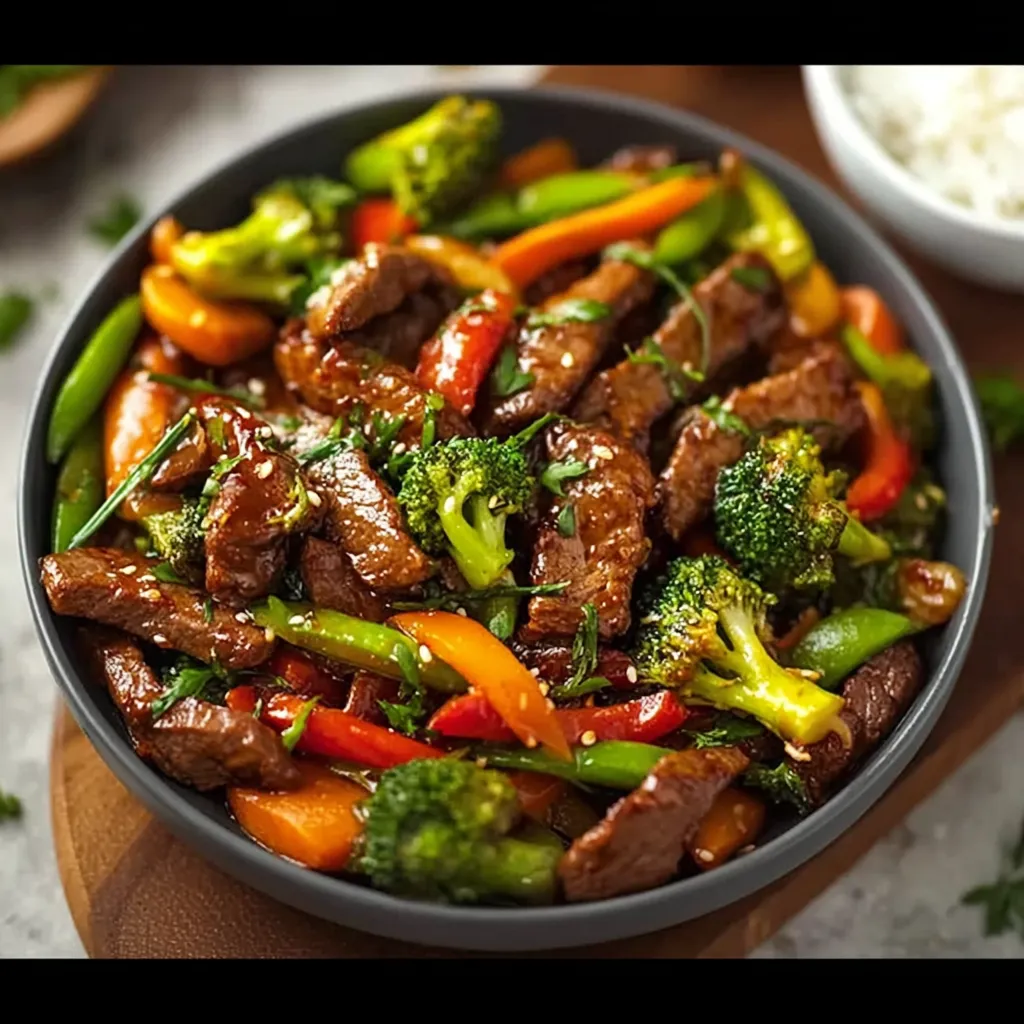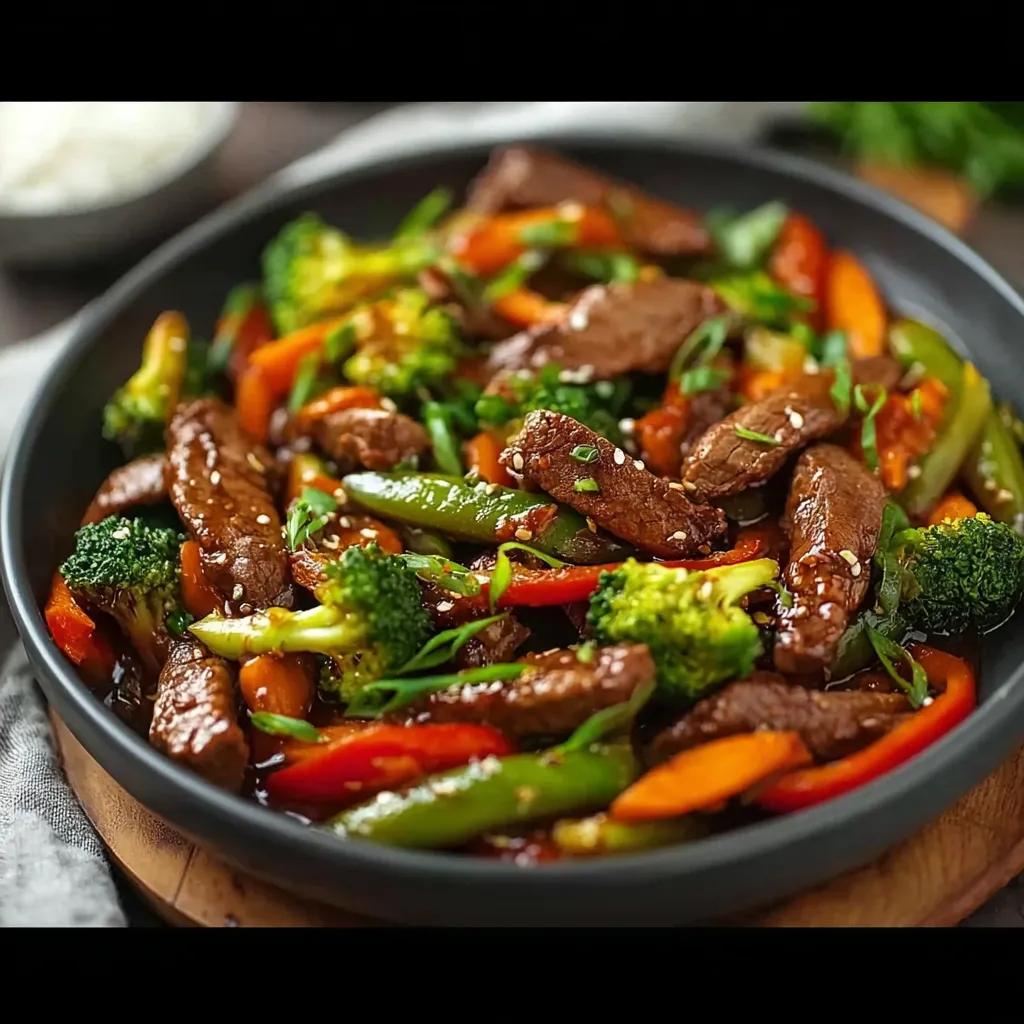 Bookmark
Bookmark
This beef stir fry is my weeknight dinner hero when I need something quick, nutritious, and packed with flavor. The combination of tender beef strips and crisp vegetables in a savory-sweet sauce creates a restaurant-quality meal that's ready faster than takeout delivery.
I discovered this recipe during a busy work week when I needed to use up vegetables in my fridge. My family was so impressed they requested it twice more that same week! The secret is in the perfect sear on the beef and not overcooking the vegetables.
Ingredients
- Beef: flank steak, sirloin, or ribeye cuts work beautifully here as they stay tender when cooked quickly at high heat
- Soy sauce: provides that essential umami foundation for the sauce
- Hoisin sauce: adds complexity and sweetness without requiring multiple ingredients
- Sesame oil: just a tablespoon transforms the entire dish with its distinctive nutty flavor
- Honey: balances the saltiness and helps create that glossy sauce that clings to everything
- Fresh garlic and ginger: these aromatics are non negotiable for authentic flavor
- Bell peppers: add sweetness and vibrant color
- Broccoli florets: soak up the sauce in all their little flowery parts
- Carrots: add natural sweetness and beautiful color contrast
- Snap peas: provide the perfect crisp texture and fresh flavor
- Green onions: for garnish add a fresh bite at the end
Step-by-Step Instructions
- Slice the Beef:
- Cut your beef against the grain into thin strips about 1/4 inch thick. This is crucial for tenderness. The thinner you slice it, the more tender your final dish will be. For extra ease, partially freeze the beef for 20 minutes before slicing.
- Create the Sauce:
- Combine soy sauce, hoisin, sesame oil, honey, minced garlic, and grated ginger in a bowl and whisk until fully incorporated. This magical mixture will transform your simple ingredients into something extraordinary. Make sure your honey is fully dissolved into the sauce.
- Sear the Beef:
- Heat your wok or large skillet until it's smoking hot. Add oil and carefully place beef strips in a single layer. The key is to not touch them for 1-2 minutes. This creates that beautiful caramelization that adds depth of flavor. Once seared, quickly stir to cook all sides then remove to prevent overcooking.
- Cook Vegetables Strategically:
- Add vegetables in order of cooking time. Start with carrots and broccoli as they take longer, then add bell peppers, and finally snap peas. Keep everything moving constantly. The vegetables should remain bright and slightly crisp when done, never soggy.
- Finish with Finesse:
- Return the beef to the pan, pour in your sauce, and toss everything together. The sauce will quickly thicken from the cornstarch and heat. Keep tossing for about 30-60 seconds until everything is evenly coated and glistening.
 Bookmark
Bookmark
My absolute favorite part of this recipe is the moment when the sauce hits the hot pan and creates that sizzling aroma that fills the kitchen. My daughter now knows dinner is almost ready when she smells that distinctive scent and comes running to the table.
Proper Beef Selection
The cut of beef you choose makes a significant difference in stir fry. While the recipe suggests flank steak, sirloin, or ribeye, my personal preference is flank steak. When sliced properly against the grain, it remains tender while providing excellent beef flavor. Look for meat with good marbling as those small streaks of fat will melt during cooking, adding moisture and flavor to your dish.
Vegetable Variations
This recipe welcomes substitutions based on what you have available. Snow peas work beautifully in place of snap peas. Water chestnuts add wonderful crunch. Baby corn, mushrooms, bok choy, or thinly sliced cabbage all make excellent additions or substitutions. The key is to maintain a similar volume of vegetables and add them to the wok based on cooking time. Harder vegetables go in first, tender ones last.
Making Ahead and Storage
This stir fry makes excellent leftovers and can be prepared partially in advance. You can slice all vegetables and beef up to 24 hours ahead and store them separately in airtight containers in the refrigerator. The sauce can also be mixed ahead of time. Leftovers will keep in the refrigerator for up to 3 days. When reheating, a quick 1-2 minutes in a hot skillet is preferable to microwave as it maintains better texture in the vegetables.
Recipe FAQs
- → What cut of beef works best for stir fry?
Flank steak, sirloin, and ribeye work best for stir fry as they offer good flavor and become tender when sliced thinly against the grain. For maximum tenderness, freeze the meat for 15-20 minutes before slicing to make it easier to cut thin, uniform pieces.
- → Can I make this dish vegetarian?
Absolutely! Replace the beef with firm tofu, tempeh, or a meat substitute. You can also add more vegetables like mushrooms to create a heartier texture. The sauce works wonderfully with plant-based proteins too.
- → What vegetables can I substitute in this stir fry?
This stir fry is versatile - you can use snow peas, baby corn, water chestnuts, mushrooms, zucchini, bok choy, or bean sprouts. The key is to add denser vegetables first and quick-cooking ones later to ensure everything is properly cooked.
- → How do I make sure my beef is tender?
Slice the beef thinly (about 1/4 inch) against the grain, which cuts through the muscle fibers and reduces toughness. A brief marination in soy sauce with a touch of baking soda (1/4 teaspoon per pound) can also help tenderize the meat. Finally, avoid overcooking - the beef only needs 2-3 minutes in a hot pan.
- → Can I prepare components of this dish ahead of time?
Yes! Slice the beef and vegetables and store them separately in the refrigerator up to a day ahead. You can also mix the sauce ingredients and keep refrigerated. When ready to cook, bring everything to room temperature for about 20 minutes, then proceed with the stir-frying steps for a quick meal.
- → What can I serve with beef stir fry besides rice?
While steamed rice is traditional, you can serve this stir fry with noodles (like udon, soba, or rice noodles), cauliflower rice for a low-carb option, quinoa, or even wrapped in lettuce cups for a lighter meal. A side of miso soup also complements the flavors nicely.
